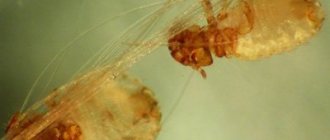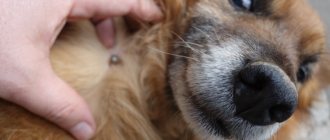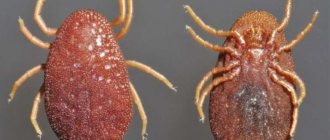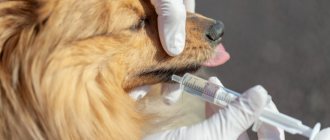Decorative rats are neat animals for which their owners provide decent living conditions.
Unfortunately, parasites are found in rats even if they are kept comfortably in an apartment, with timely cleaning and regular disinfection of the rodent cage. If your pet rat has become restless, often itches and bites fur with its teeth, scratches, bloody crusts, and areas of baldness appear on its body, then you should suspect that your furry friend has external or subcutaneous parasites. In such cases, it is advisable to immediately take the pet to a veterinary clinic to clarify the diagnosis and prescribe effective treatment, otherwise rat parasites can cause exhaustion and death of the animal.
Where do parasites come from in decorative rats?
Inexperienced rat breeders often ask a similar question when they discover parasitic animals on the body of their beloved pet. A domestic rodent can pick up parasites even with very careful care and maintenance; they can be their sources.
Filler
Often, lice eaters and ticks live in hay and sawdust, which animal owners buy in dubious places and use as filler.
Contact with infected animals
They can be domestic or wild mice and rats.
External environment
Even a loving owner who brings the infection from the street on his hands and clothes can give his pet parasites.
Diseases
The parasite's bites cause an itchy skin irritation in humans called rat mite dermatitis. Children may have an eczematous or vesicular reaction to the sting. Rat mite attacks must be differentiated from other insect bites or skin irritations caused by the body's reaction to an allergen.
Treatment of rat tick-borne dermatitis is symptomatic. To alleviate the condition of the victim, use:
- oral antihistamines;
- topical corticosteroids;
- benzyl benzoate;
- gamma-benzene hexachloride;
- Crotamiton.
But often the irritation goes away on its own or people simply do not react to the saliva of rat bloodsuckers.
Rat mite
The reaction to rat parasites must be separated from the symptoms:
Laboratory studies have also shown that rat mites can carry dangerous diseases:
In unfavorable times, rat ticks, along with fleas, were the main carriers of typhoid and plague from rodents to people.
Major rat parasites
In decorative rats you can find different types of ectoparasites, all of which cause unbearable itching and anxiety to the animal.
lice eaters
Red wingless small insects no larger than 1 mm in size with an oblong elongated body covered with bristles, shaped like cat fleas. In light-colored rodents, adult insects can easily be detected in the fur. Rat pests feed on particles of the epidermis and blood of the rodent.
Infection of domestic rats with lice eaters is accompanied by severe debilitating itching in the rodent; the domestic rat becomes very restless, twitchy, often itches intensely, refuses to eat, and progressive exhaustion is observed. There are numerous wounds, scratches, and bruises on the pet’s body, accompanied by severe swelling and inflammatory processes.
Lice eaters in rats multiply rapidly; an adult female lays more than a hundred nit eggs, which stick to the animal’s fur. The owner can detect light shiny inclusions on the lower back and near the tail, fixed in the pet's hair and reminiscent of ordinary dandruff. It is almost impossible to remove nits from a rat's fur, only by completely removing the animal's hair. A huge number of larvae emerge from the eggs, which within a month become adult, sexually mature individuals.
The parasitism of lice eaters in rats is dangerous due to the death of the pet, so treatment should begin at the first characteristic symptoms of infection.
Lice
Lice in rats cause severe itching and anxiety; these parasitic insects feed only on the blood of a domestic rat; per day, one louse attaches itself more than 10 times to the animal’s skin. Adults can only be seen under a microscope; the body size of the parasites is no more than 0.5 mm.
Rat lice are small red insects with an elongated body, at the head end of which there are hooks for holding on the animal’s body and two sharp stilettos for piercing the skin. The louse cuts through the skin, injects substances that prevent the rodent's blood from clotting, and attaches itself to the animal's body.
Reproduction of lice occurs in the same way as in lice, with the deposition of nit eggs and the hatching of nymphs, which turn into sexually mature individuals. White shiny nits of lice can be found on the fur of a rat; parasitism is accompanied by severe nervousness of the animal, active itching, lethargy and apathy of the pet; the development of anemia, typhus and hemobartonellosis in the rat is possible.
Fleas
Rat fleas are unpleasant blood-sucking insects of a red-brown color with a characteristic body flattened on both sides, the size of the insect is 2-5 mm. The flea is capable of jumping long distances and clinging to the host's fur with tenacious claws, and is capable of migrating between cats, dogs and rats.
When infected, pets constantly scratch itchy areas, become restless, and may develop anemia. Dried burgundy crusts can be found on the animal's body - flea secretions; when bathing a rat, they turn the water pink.
Mites are very common in rats; there are several types of parasites that live on the skin and in the epidermal layer. The rat tick is red-brown in color, 0.1-1 mm in size, has an oblong flat body, feeds on the blood of an animal and carries various serious diseases. With a lack of nutrition, the tick is capable of attacking humans.
IMPORTANT!!! Rat mites are dangerous to humans! People, especially children, have a hard time with eczematous dermatitis, which develops as a result of parasitism by these insects. Ticks infect people with typhus and murine typhus, tularemia, plague, rickettsial infections and Q fever.
Subcutaneous mites live in the upper layer of the epidermis under the skin of a rodent. It is impossible to visually detect these mites; the diagnosis is made only on the basis of examination of skin scrapings under a microscope.
Parasitism of ticks on the body of a rat is manifested by characteristic symptoms: hair loss and the formation of multiple swollen red wounds on the neck, head, spine and shoulders of the rodent.
Ear mites primarily attack the delicate skin of the ear, pinna and nose, which is manifested by the appearance of yellow or red growths on the ears, nose, limbs and genitals.
Bedbugs
Ordinary bed bugs can also drink blood from decorative rats, causing severe itching, scratching, anemia, and infection with blood parasites. Bedbugs attack domestic rodents during periods of food shortage or the absence of a person nearby as a food source.
Rat mite (Ornithonyssus bacoti) – what it looks like, life cycle, habitat, features
This is a small tick, the body length does not exceed 1.44 mm, but individuals with a length of 0.78 mm (females) and 0.53 mm (males) are more common. Offspring parameters:
- eggs – 0.34 mm;
- larvae – 0.3 mm.
Rat mites, like other representatives of the order, are covered with sensitive villi. They have 4 pairs of limbs, but the front 2 legs are longer. The outer covers are transparent light brown. After eating, the tick enlarges several times, and the color changes to dark red.
The parasite climbs onto the host when it needs to get a portion of food. It has a piercing-sucking type of mouthparts, which allows it to pierce the skin and suck out blood at a rapid pace, since the digestive system works on the principle of a pump. It is found in temperate and tropical climates, but does not live in cold regions. The main host is a rat (gray).
In the absence of a food source,
the parasite transfers to the mouse. Less often it bites other rodents.
If there is no suitable food nearby, rat ticks can bite a dog or cat, and sometimes a person. But at this stage of life the pest does not reproduce. For the birth of offspring, the blood of rodents is necessary. Moreover, the life expectancy of a person is 1.5 months. Life cycle of pests:
- egg;
- larva;
- protonymph;
- deutonymph;
- imago.
Moreover, the development cycle is short - about 16 days, sometimes less (from 7 to 12 days), which is determined by the ambient temperature. Most often, such pests live for 2.5 months, but the lifespan of males can be reduced to 45 days. Females, on the contrary, can survive for 9 months. They lay up to 100 eggs during this period, but they do this not at once, but in batches one at a time.
Rat ticks can carry serious diseases
Attack of rat ticks on adults and children - complications
Soon after a bite, people develop dermatitis of unknown etiology. Moreover, they are complicated by severe itching, the formation of papules, vesicles, and rashes over large areas of the skin. Bite marks are found where the fabric of clothing adheres more tightly to the outer skin. At the same time, a hyperemic area appears. Less frequently, the temperature rises and headache appears. This is caused by the body’s reaction to the substance introduced by the rat parasite (in saliva), as well as harmful microorganisms that the pest carries on its body.
Rat mite (Ornithonyssus bacoti)
What medications are used to make you feel better after bites?
When rat mites attack a person in an apartment, you need to use the most effective means with antiseptic, antimicrobial and antiparasitic properties:
- Benzyl benzoate ointment;
- Sulfuric ointment;
- Wilkinson's ointment;
- Bensocryl;
- Salicylic-zinc paste;
- Spregal.
What and with whom can the reaction to rat bites be confused?
When traces of contact with parasites appear, it is important to recognize who exactly attacked. If the tick has already crawled away, you need to be guided by the external signs of bites. A red spot remains with a dark dot in the center. These are nonspecific signs characteristic of most parasites. At the initial stage (during the first day), the bites of the rat parasite resemble traces of contact with mosquitoes and midges. But in the first case, the affected areas of the skin do not change much. In comparison, dermatosis caused by rat pests develops dermatitis later.
Midge bites
more painful, the affected tissues soon swell.
Rat tick bite on a human body
Rat mites can be a carrier of very dangerous diseases for humans.
Such parasites are carriers of pathogenic microorganisms, and they also pose a danger to humans. Diseases spread by such pests:
- rat typhus;
- Q fever;
- Lyme disease;
- icteric leptospirosis;
- smallpox or vesicular rickettsiosis;
- tick-borne encephalitis;
- West Nile fever;
- tularemia;
- plague.
Treatment of an infected rat
Specifying the type of parasite and prescribing treatment should be carried out by a specialist in a veterinary clinic, since different medications are used to destroy external and subcutaneous parasites. In case of complications, the animal is prescribed anti-inflammatory ointments, immunostimulating drugs and a course of vitamins and antibiotics.
Insecticidal preparations are highly toxic; if handled incorrectly or in excess of the dosage, there is a risk of poisoning a decorative rat. It is advisable that the animal be treated by a veterinarian; it is also permissible to treat a furry pet at home in a well-ventilated area, strictly following the recommendations of a specialist.
At the same time as treating your pet, you need to throw away the bedding, disinfect the cage and all accessories several times, change the filler, and treat the entire room with repellents. It is advisable to throw away all wooden objects from the cage; they can be places where parasites accumulate. The rodent's claws should be trimmed short during treatment to prevent scratching of the skin.
When keeping domestic rats in groups, all rats must be treated repeatedly to avoid re-infection. If a pet is bitten by fleas or bedbugs, it is recommended to treat all pets living in the house with insecticides, as well as the room itself: carpets, upholstered furniture, mattresses, floors, etc.
Prevention measures
Preventing the occurrence of rat mites primarily involves timely getting rid of rodents that carry them. Includes the following measures:
- Control over the size of the rat population and constant measures for deratization in areas inhabited by rodents.
- Isolation of premises from rats. The sealing of manholes is carried out by residents.
- Maintaining premises in proper sanitary and technical condition.
You should know that rat mites reproduce in warm conditions and in the presence of food. It can develop all year round, but is especially active in the spring. Parasites are very easy to disinfest and die almost immediately. Most often, to get rid of them, a one-time treatment of the premises is enough. However, after a while they may appear again if preventive measures are not followed. If ticks reappear, acaricide treatment is carried out again.
Sources
- https://misterklop.ru/klesshi/krysinye-i-myshinye-kleshhi-kto-eto-kak-vyglyadyat-na-chyom-parazitiruyut-mogut-li-prichinit-vred-cheloveku-sposoby-borby-v-domashnih- usloviyah
- https://likehamster.ru/domashnie-krysy/o-zdorove/parazity-u-krys-kak-borotsja/
- https://parcenter.ru/myshi-i-krysy/kleshhi-u-dekorativnyh-krys.html
- https://homkin.ru/krysy/zdorovie-krys/blohi-vlasoedy-vshi.html
- https://hlopklop.com/zhiv/krysinye.html
- https://dezplan.ru/vopros/krysinye-kleshchi-foto-ukusov-i-lechenie
- https://TezarVape.ru/ektoparazity/kleshchi-u-krys.html
- https://sichovka.ru/parazity/gamazovye-kleshchi.html
[collapse]
Quarantine
- Preventive quarantine when introducing new animals into a group is 14 days. During these 14 days, animals are kept separately, regardless of where or from whom you purchased these (or one) animals, and regardless of the fact that these animals do not show any signs of illness. During these two weeks, the animals are monitored and hygiene measures are observed to prevent the transmission of possible infections through hands and animal care items. It should be remembered that hands are the main source of transmission of infections and infestations.
- Quarantine can be not only preventive, but also forced. The necessary measure is to keep clinically healthy animals isolated from clinically sick ones. Otherwise, the entire group of animals can become infected and fall ill. And then the scale of the “disaster” can become significant.
- Mycoplasma pulmonis and Streptococcus pneumoniae are pathogens that cause chronic respiratory syndrome in rodents and can be transmitted by direct contact and by airborne droplets. These pathogens infect the lungs, cause otitis media, and in females cause the development of endometritis. Mycoplasma and streptococcus are dangerous for rats, hamsters, gerbils, guinea pigs and chinchillas. Rats, often suffering from otitis media and systemic respiratory infections, become over-infected in a group and everyone gets sick.
- Chinchillas are re-infected with giardiasis and everyone in the group gets sick.
- Myxomatosis in rabbits is extremely contagious. To date, there is no effective treatment for myxomatosis. Vaccine prophylaxis is used.
Following simple quarantine rules will help keep your pets healthy and alive.
Vaccination of rabbits
- Associated vaccine against myxomatosis and viral hemorrhagic disease (VHD) of rabbits, dry . After vaccination, immunity occurs on the 5th-7th day and lasts for at least 12 months against VGBV and 9 months against myxomatosis. The vaccine is used from 1.5 months of age. Rabbits are vaccinated at any period of pregnancy. Revaccinate every 9 months. In areas unfavorable for myxomatosis and VGBV, young animals are revaccinated after 3 months. It is prohibited to vaccinate sick animals. Before administration, the vaccine is dissolved with saline or distilled water and administered subcutaneously or intramuscularly in a volume of 0.5 cm3.
- The Nobivak Myxo-RHD vaccine against myxomatosis and viral hemorrhagic disease of rabbits forms immunity after 3 weeks, which lasts for at least 12 months.
When using any of these vaccines, only clinically healthy animals are subject to vaccination. Vaccination is carried out by a doctor after a complete clinical examination of the animals. A mandatory rule when carrying out vaccination is regular deworming of rabbits or preliminary 10-14 days before vaccination. It is prohibited to vaccinate clinically sick or weakened rabbits.
If you have a small animal, then it has already become a member of your family, which has the right to attention, care and love.
Remember, contacting a veterinarian in a timely manner will help save your pet. Due to the rapid metabolism of a pet, any disease develops faster than in larger animals.
When writing the article, material from Yu.E. Malysheva was used. veterinary surgeon, leading specialist in the treatment of rodents and exotic animals (rodentologist), veterinary clinic "AmVet", Moscow
Health to you and your pets!
How to distinguish a healthy pet from a sick one?
A healthy pet always:
- well-groomed, shiny coat, without bald patches or tangles (if the rodent is not hairless)
- clear skin, no wounds, eczema or rashes
- clear, shiny eyes without discharge
- clean nose and ears
- clean area under the ponytail
- smooth breathing without wheezing or whistling
- moderately well-fed body, without protruding bones
- behavior is normal, without sudden changes, appetite is preserved
If you are already the owner of a small pet, then you need to adhere to the following rules to avoid diseases of your little friend.
Symptoms of the disease
Rats
The animals develop restless behavior, poor sleep and appetite, and continuous biting of their own fur. Wounds, abrasions, scratches and crusts form on the skin.
When examined, lice eaters are clearly visible - both insects and their nits - whitish grains attached to the hairs.
Guinea pigs
Symptoms of infection are similar to those of rats: constant restlessness, the animal itches incessantly, sleeps little and loses appetite.
Upon examination, sores and scratches, swarming parasites and white nits on the hairs are discovered.
Rabbits
Lice eaters can settle on both ordinary and ornamental animals. Symptoms of infection will not be different at all. Rabbits will be bothered by severe itching of the skin, which they will try to pacify by constant scratching. Bald patches and scratches may appear on the skin.
They can easily turn into dermatitis.
Cows
Damage to the skin in the form of scratching, even bleeding, severe dandruff on them, areas of the skin with a lack of hair (bald patches), the appearance of inflamed folds.
The coat becomes dull, lacks a healthy shine, and feels rough to the touch. In addition, appetite decreases and, as a result, the amount of milk decreases. Cows show anxiety, become nervous and irritable, may not allow their owners or veterinarian to approach them, and do not allow themselves to be milked.











